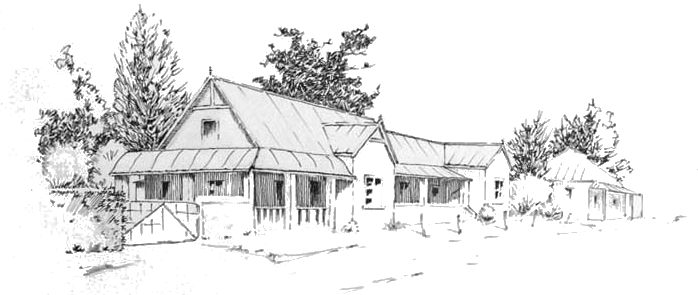A five-year drought in the Eastern Cape fortuitously broke in mid-summer a month or so before the annual fly fishing festival in Rhodes and the organizer, Dave Walker says it was one of the best festivals in years.
Basie Vosloo, whose farm Birkhall in neighbouring Barkly East features in all of Tom Sutcliffe’s recent books, told me that the small leaf-eating Chrysomelidae beetles were present in huge numbers on the Sterkspruit river which runs through his farm.
Click in images to enlarge them
The willow-lined Sterkspruit where beetles and inchworms play a major role in trout diet
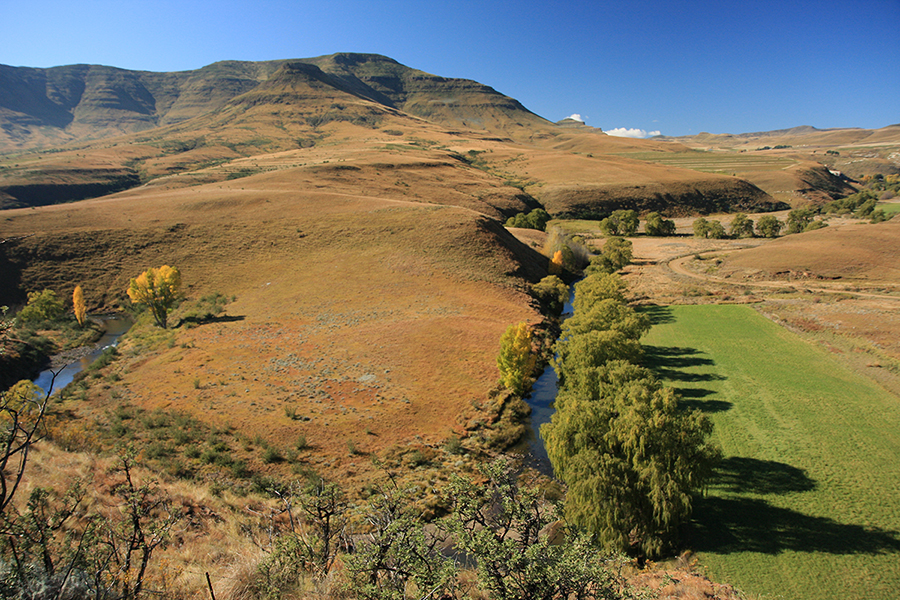
and anglers love the challenges and the fishing opportunities the willows present


The larvae are just as ubiquitous in the willows along the Sterkspruit and the trout are constantly on the alert, waiting for the plop of a falling beetle, beetle larva or inchworm which occurs constantly whenever the wind blows.
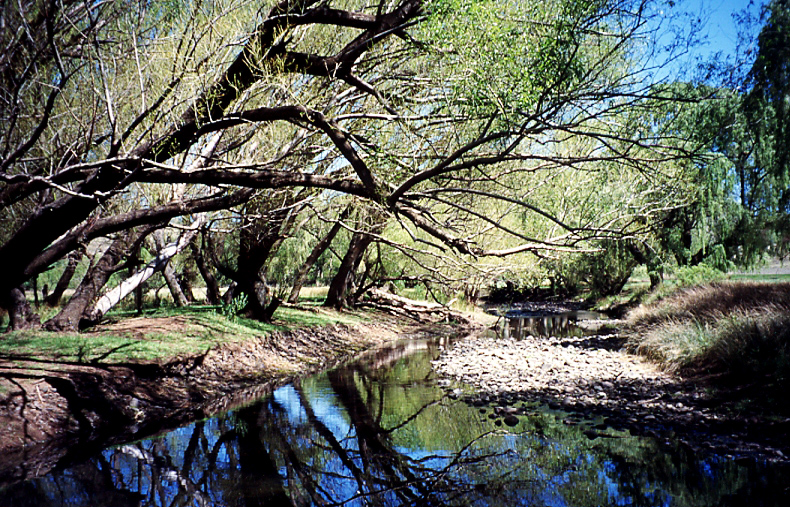
Picture above. Between them, the Birkhall Beetles and the inchworms defoliate the willow trees on the Sterkspruit – and provide regular drop-in sustenance for the trout and yellowfish.
Below, the leaf-eating beetle found in huge numbers on the willow trees in Barkly East and Rhodes. Note the inchworm on the twig behind it.
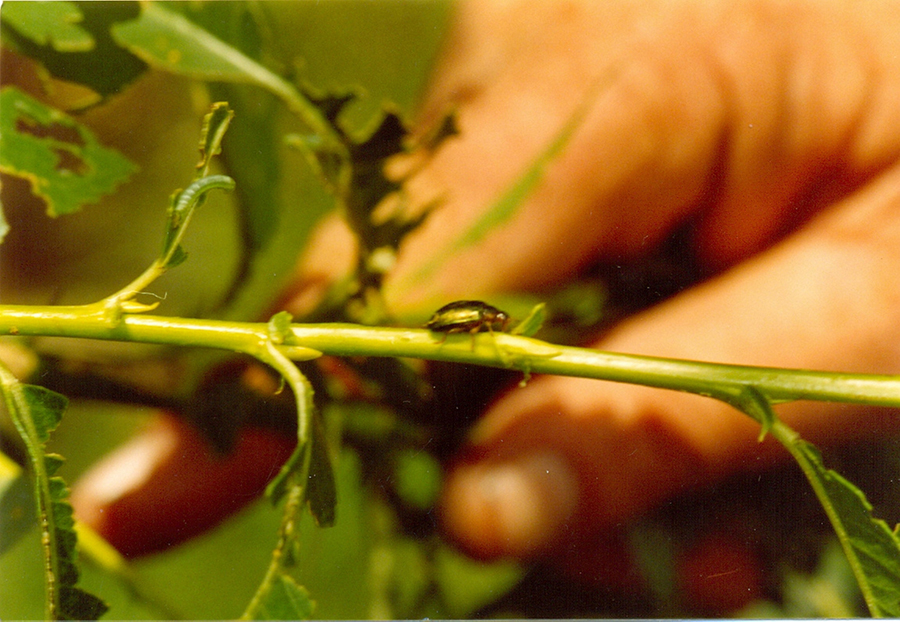
The small, black larvae of the Chromelidae beetle also play a role in trout diet on the Sterksruit and other streams in the area, as does the inchworm.

Willows are ubiquitous in Barkly East and Rhodes. The Sterkspruit with its willow-lined banks on Basie Vosloo’s farm, Birkhall.

An angler on the Bokspruit on the Knockwarren section
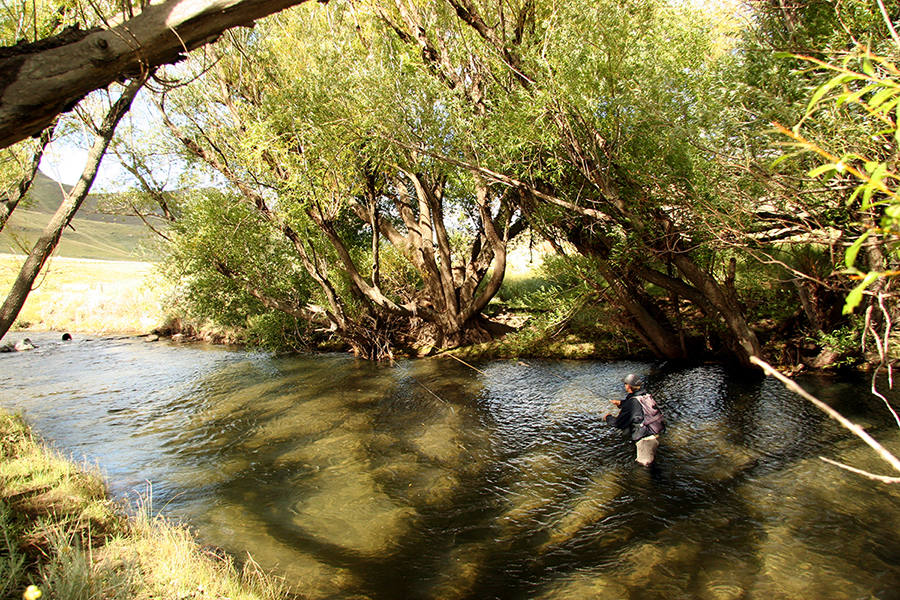
Paul Curtis fishing the aptly-named Willow Stream on the farm Balloch.
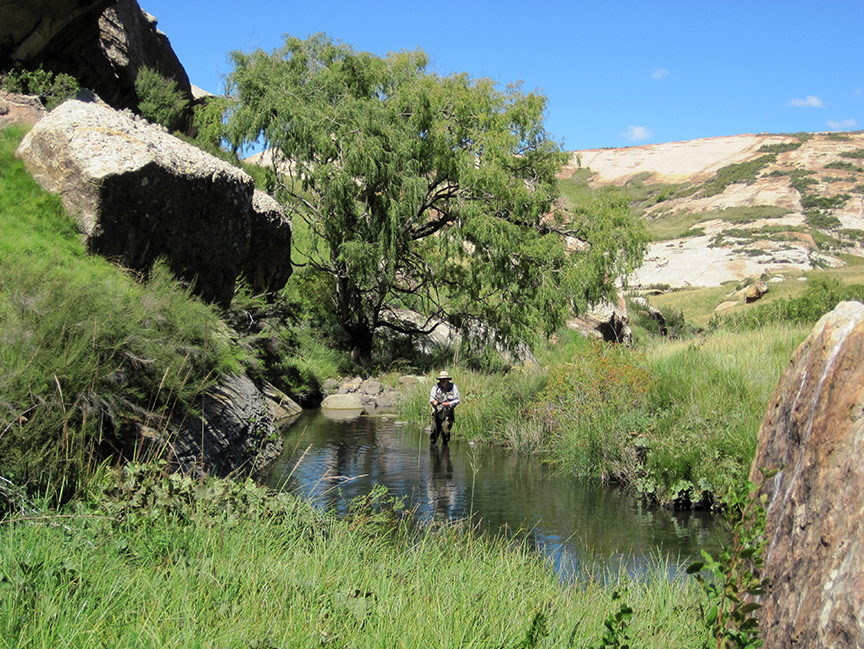
When I started fly fishing on the streams near Cape Town in the early 1980s I read everything I could find on hunting trout in small streams and my favourite author was Mike Weaver whose article on fishing streams in England like the Dart, the Teign and the Liddle appeared regularly in Trout & Salmon.
I bought his book The Pursuit of Wild Trout when it was published in 1991 and there was one particular passage that fired my imagination.
Weaver wrote that his favourite terrestrial imitation was the deer hair Crowe Beetle but when that was ignored, particularly when the streams were low and clear, he turned to a simple pattern he calls the Black Bug and it invariably proved successful.
Hook: #16 -20
Body: Peacock herl over lead wire
Shellback: Crow or other black herl, secured front and rear
Says Weaver:
‘For some unknown reason, even the most supercilious trout in smooth shallow water is vulnerable to this fly when presented on a long leader with a very fine point.
‘Though this pattern sinks quickly, it is usually taken with a visible swirl within a second of hitting the water if it is going to be taken at all. If it does have time to sink before a trout takes, the draw of the leader along the surface is easily seen by the angler in the smooth water’.
Another angler who found the slightly-sunken beetle to be deadly was Eric Horsfall Turner. He fished it upstream on a greased leader and you can read his account on the Cape Piscatorial Society website.
Keep in mind that aquatic beetles like Diving Beetles, Water Scavenger Beetles, Whirligig Beetles, Backswimmers and Water Boatmen are also familiar to trout and the possibility that Horsfall Turner's Beetle, a Coch-y-Bonddu with a yellow tag, could be taken as a swimming beetle has been mooted. This is an avenue that Alan Hobson has been exploring with great success.
Peacock herl is the main constituent in two British flies, the Coch y Bonddu and Tome Ivens’ Black and Peacock Spider. In his book, 50 Favourite Wet Flies (A.C. Black, 1986) T. Donald Overfield, quotes a letter from another well-known British angling writer, Conrad Voss Bark:
‘I have fished the Black and Peacock Spider almost everywhere for trout, especially in late summer and autumn on the chalk, limestone and spate rivers; practically always fished upstream and dropped down with a noticeable plop well above a fish or a place where a fish is likely to be. Sometimes the fish comes to it with such a splash you practically drop your rod. At other times they just suck it down as though they know the beetles cannot escape.’
For beetle patterns, the silhouette is everything or, to be more precise, the GISS formula utilised by birders – general impression of size and shape.
In the 1950s a plague of alien beetles started attacking roses in Pennsylvania, home of legendary spring creeks like the LeTort Spring Run and the Little Breeches.
Initially, they were caught on coffee beans cemented to a hook by anglers like Vincent Marinaro and Charlie Fox but this ‘fly’ was superceded by more realistic deer hair patterns developed by Chauncey Lively and others.
The ancestor of all our modern beetle patterns was a fly made of deer hair, the Crowe Beetle which Mike Weaver favoured as a dry fly. It is definitely a blue collar fly, both in origin - the former steel-producing city of Johnstown, Pennsylvania – and in its construction. A single tuft of black-dyed deer hair is tied in by the butts at the bend of the hook, folded forward and tied off at the eye. The stub of hair at the eye replicated the head of the beetle and a few strands, protruding sideways, the legs. John Crowe’s The Book of Trout Lore was published in 1947.
The sketch scanned from John Crowe’s The Book of Trout Lore (A S Barnes, 1947) showing the simple construction of his deer hair beetle imitation.

Marinaro’s Jassid is very much a silhouette pattern.
Weaver’s Black Bug started me on a happy and successful journey of fishing sunken terrestrials with a strike indicator which I outlined in a chapter of the book on indigenous South African fly patterns, which Peter Brigg and I wrote two years ago.
That chapter can now be found on the Cape Piscatorial Society website.
Eventually I settled on a #16 Red Tag – called ‘Heroin for Trout’ in Tasmania - with a tiny 1.5 mm black brass bead at the eye to make it sink slowly and I fished it with a strike indicator.
Then just to add, I recently came across an interesting technique for tying foam rubber beetles on the website of Malaysian fly tyer, Dron Lee, in which he ties two pieces of this material at the bend of the hook and folds them forward to create a beetle shape.
When I spotted UTC Mini Sparkle Braid in peacock on the Xplorer website of local Wapsi agent John Geils, I realised that I could create a realistic imitation based on the birder's GISS-formula of the Birkhall Beetle using Dron’s technique.
Dressing
Hook: #16 Dohiku 303 ‘Beetle Hook’
Thread: 18/0 Semperfli Nanosilk – black or olive
Bead: Black 1.5 mm brass
Shellback: Peacock UTC Mini Sparkle Braid
UV resin: Solarez Emerald Green or Loon Fly Finish in olive
Body: Peacock herl wrapped round tying thread lightly touch-dubbed with Grip Fine Super UV Dub Dark Olive or similar
The short shank, heavy wire ‘Beetle Hook’, sold by the local Dohiku agents, Upstream in Cape Town, has become a great favourite with competition fly anglers.
The thinnest Semperfli Nanosilk, is extremely strong (2.5 lbs breaking strain) and it enables you to apply a lot of pressure when tying down relatively thick synthetic materials like braids.
The UV Dub emits tiny points of light and combines well with the iridescence of the peacock herl in creating the body.
Once the fly is complete I trim the peacock herl to make it as streamlined as possible so that it sinks quickly.
To make the fly more durable, I coat the sparkle braid with UV light cured resin.
As an optional measure, I add green glitter dust - available from craft shops like PNA - to the UV resin and it also emits sparkles of light.
I have used a Miyuki 15/0 Rocaille bead in the following sequence of photographs but a 1.5mm black brass bead is the more durable choice.
1: Attach the bead and tie a section of braid on either side of the hook. Leave a small section of the hook behind the bead open to accommodate the two strands of braid when they are folded forward to create the top of the fly.
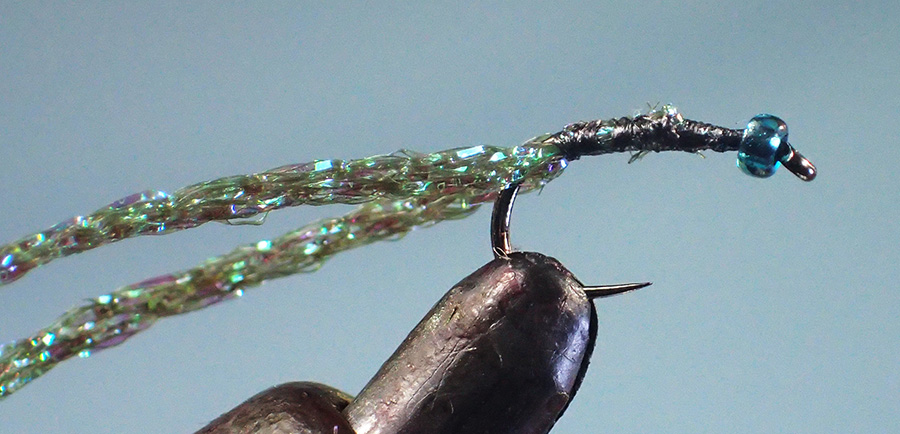
2: Tie in three strands of peacock herl and wrap them around the thread which has been loosely dubbed with UV Dub . Palmer this combination forward and tie off, leaving a space behind the bead.

3: Fold the two sections of braid forward and tie off just behind the bead. Coat the top of the braid with UV resin which you can mix with green glitter dust to enhance the sparkle.

Keep in mind that the Wapsi Mini Sparkle Braid is available in other appropriate colours such as black and copper and one could use Fishient’s Fuzzy Bug or Straggle String combined with peacock for the body.
Scientific research has shown that once the spring hatches of aquatic insects are over, the bulk of trout food consists of terrestrial insects and, over the course of a season, more terrestrials are eaten by trout because they are available for more hours of the day than the sporadically-hatching aquatic insects.
In their book, Terrestrials - A Modern Approach to Fishing and Tying with Synthetic and Natural Materials (Stackpole Books, 1994), authors Harrison Steeves and Ed Koch estimate that terrestrial insects are more available to trout than aquatic insects by a ratio of 7-1.
This is borne out by a study cited by the late Charles Brooks in his books, The Trout and the Stream (Crown Publishers, New York 1974). Using drift nets to trap floating insects, scientists found that in early spring 80 percent of floating food taken by trout consisted of aquatic insects. By midsummer, the balance had shifted and now 60 percent of trout food consisted of terrestrial insects. Taking the year as a whole, the trout derived 70 percent of their food from non-aquatic, land-based insects.
"Match the hatch if there is one on but if there is not, look to terrestrial insects", said Brooks.
It is not difficult to understand why the beetle is such a successful fly. While mayflies have become the symbol and leitmotif of fly fishing, beetles are far more prevalent in trout diet. Beetles, or Coleoptera to give them their Latin name, are the largest order of living organisms with an estimated 350 000 species. In contrast to this the mayflies have about six hundred different species. Most mayflies breed only once a year and the adults live for about two days at most. Many species of beetles however are multi-brooded, producing up to four generations a year.
What is even more significant from a fly fishing perspective is that beetles are exactly the same shape as another large order in the insect kingdom, the bugs or Hemiptera and there are some 60 000 species, such as leafhoppers, cicadas and aphids, in this family. The major difference between beetles and bugs is that the beetles have jaws with which they bite and chew, but the bugs live exclusively on liquids and have sharply pointed snouts adapted for piercing and sucking either sap from plants or blood from other creatures. Thus we have four hundred and ten thousand species of insect sharing the same general silhouette - an oval shape with three legs on either side - and which are available throughout the year, compared with six hundred species of mayfly which are available as adults for a brief period each year
I believe that, on the Sterkspruit, trout are attuned to the plop of falling terrestrial insects, not just the leaf-eating beetles and their larvae but inchworm as well.
In 1916, Salix fragilis, the crack willow, had been imported and planted in Barkly East in the hopes of starting a basket weaving industry. Like all invasive aliens which lack natural enemies, they quickly spread throughout the Drakensberg highlands and, like the wattle, quickly infested watercourses.
Then, in 1993, a consignment of plants that were imported into Lesotho contained a sawfly, Nematus Oligospilus Forster that predates on this tree.
The sawfly larvae found a century-old banquet awaiting them and their numbers exploded.

The Chrysomelidae beetles also found the crack willow to their liking.

I caught my biggest Sterkspruit trout, which weighed more than three lbs, after seeing fish swirl and slash sporadically at something that was clearly on or close to the water surface. I crossed the river higher upstream and crept down the bank to a large willow close to where the fish were moving. The wind rustled the branches above me and the penny dropped along with the inchworm that bounced off my head.
My imitation was taken with a swirl and, after an exciting fight, I landed the fish only to find that it was bleeding fatally from its gills. The stomach contents showed that it had been feeding exclusively on beetles and sawfly pupae in their silken cases. The underside of the rocks on the stream bed teemed with mayfly nymphs that were only accessible when they left that shelter and set off on the perilous journey towards adult metamorphosis at the surface – and I believe that that occurs most often at night.
I believe this version of the Birkhall Beetle meets all the criteria of size, shape, and colour and is easy to tie.
Slant tank image of a beetle

As this slant tank photograph of a Brown Monkey Beetle – particularly prevalent of the streams near Cape Town in spring – illustrates, the wings often protrude when a beetle is in the water.
AK Best felt this is an important trigger on floating beetle patterns and used hackle tips which are fragile.
One could add a wing of the thin but tough plastic used to wrap food in supermarkets and use fine rubber or micro-crystal flash for legs, but Mike Weaver did not find these additions necessary when he fished his Black Bug at the height of summer in the UK.
I would fish the Birkhall Beetle with a leader incorporating Scientific Anglers Tri-Colour sighter mono greased with Mucilin to about a metre from the fly.
To summarise, the Sterkspruit and many other streams in the Barky East and Rhodes districts offer a fine source of terrestrial food to trout and as the images in this article have shown, willows are very prevalent in the area.

Ed Herbst May 2020


